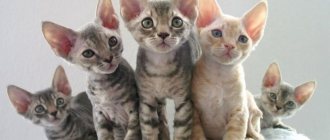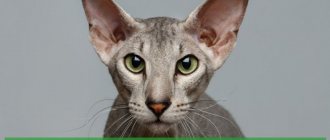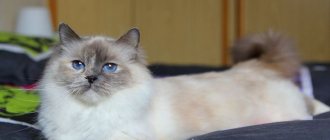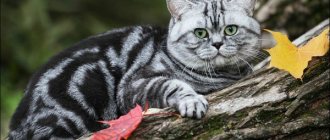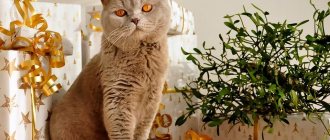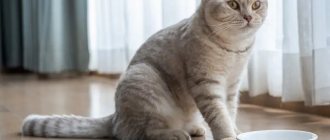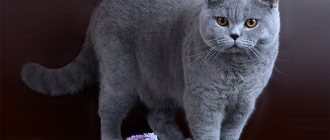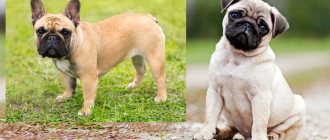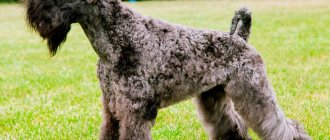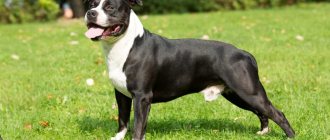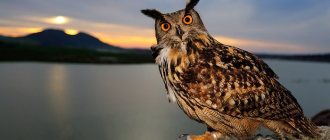“British” and “Scottish” are very often confused, but in fact these animals have many differences. The most obvious of them is the ears. Folding is characteristic exclusively of cats from Scotland, but it does not exclude straight-eared representatives from them. This feature can easily confuse an inexperienced cat lover, and the presence of lop-eared “British” cats in advertisements for the sale of kittens further increases misunderstanding.
If you don’t know how British cats differ from Scottish ones, then don’t rush into buying a pet - study detailed information about both breeds. This will help avoid deception by unscrupulous breeders.
What kind of cat breed is Scottish Fold and Scottish Straight: definition, photo
The Scottish Straight cat is a straight-eared cat bred in Scotland in the 1960s from the British cat breed.
The Scottish Straight is medium in size and appears to be quite well-fed (especially boys), due to its round cheeks that extend into a short neck. The weight of a cat is up to 3.5 kg, a cat – up to 5 kg. The legs are short, the tail is of medium length, the ears are wide at the base, pointed at the tips, spread to the sides. The eyes are large and round; because of them, a kitten, and then an adult cat, has a childish expression on its face for the rest of its life. The nose is small. The coat is thin, moderately long, as if plush, of various colors (black, gray, chocolate, brindle).
The Scottish Straight cat is balanced and easygoing, gets along with everyone in the family, but at the same time she has a sense of self-esteem. She chooses one owner, is very smart, understands every word, is curious, resistant to stress, easily tolerates moving, gets along well with other animals.
Scottish cat breed Scottish Straight
The Scottish Fold or Scottish Fold cat is very similar to the Scottish Straight in all respects, but its ears are folded forward, some folded 2 or 3 times. Also, the Scottish Fold has a shorter tail. Among Scottish Fold cats there are different characters: slow, agile, slightly aggressive, affectionate, but this breed has one feature - to remember what is beneficial to it .
Scottish cat breed Scottish Fold
Note : Only chocolate-colored cats of the Scottish breed produce litters of different colors and shades.
A Scottish kitten quickly gets used to the toilet and scratching post; the only thing it can’t stand is being forced to do anything .
Scottish cats are in good health; no genetic diseases have been detected. You can feed them :
- Canned food at room temperature, but not all the time.
- Mixed diet (dry food as the main food, and complementary foods - fish, milk, milk porridge, chicken, beef liver and meat, boiled vegetables).
Important . Fur, like the plush of Scottish cats, is difficult to remove from the stomach of the animal, so as not to harm the cat, while still a kitten, at the age of six months, it is taught to eat a special paste that removes hair.
What is the British cat breed: definition, photo
British Shorthair cat breed
According to one version, the ancestors of the British cat breed were brought to the British Isles by the ancient Romans at the beginning of our era. Of course, they didn't look the same as they do now. Over time, the cats got used to the humid and cool climate of the islands and acclimatized. The main purpose of ancient cats was to catch rodents.
The first cat show in Great Britain took place in 1871, and the cats were recognized as purebred and began to be called British.
The British Shorthair cat is larger than average in size, girls weigh up to 4 kg, boys - up to 6 kg. They are squat, with a wide chest, well-developed muscles, short thick legs and a thick tail, a massive head, thick cheeks, a small nose, and medium-sized ears. The Briton's coat is thick and short, of different colors and shades, but the classic ones are lilac and blue.
Breed Features:
- Pronounced fold of skin around the neck
- On the nose, closer to the forehead, there is a small depression
- The chin is aligned with the nose and upper lip
- Kittens have bluish-blue eyes, gradually changing to bright orange - in adults, green and blue eyes are occasionally found in this breed
- Very thick short coat, plush in appearance
British cats of these colors can take part in competitions:
- Plain
- Painting with a pattern
- Tortoiseshell (tri-colored, when one color smoothly transitions into another)
- Smoky
- Combination of two colors
- Chinchilla (faint various colors)
- Siamese color type (on the face, tail and paws the fur is darker than the rest)
The British cat is characterized by good health.
Differences in appearance
Anyone can recognize representatives of the British breed, even those who are not an expert in cat breeds. The main external differences between cats of this breed:
- the first difference is the regular round shape of the skull, which seems quite wide;
- second difference: all British people have jowls;
- straight, wide, but flattened nose with dimples in the bridge of the nose;
- small, but always straight ears, located at a great distance from each other and quite low;
- the shape of the eyes is close to a perfect circle;
- the most popular eye color among cats of the breed is light brown, almost golden, ocher;
- pure breed representatives do not have a pale rim around the pupil;
- sometimes there are blue eyes;
- The difference between the British is a strong, muscular body structure, a wide back, powerful paws, a strong torso;
- the tail is cone-shaped, strongly tapering towards the tip;
- weight - about 5-6 kg, but some animals reach 7 or more kg;
- According to the type of coat, they are divided into two branches - long-haired and short-haired;
- There are several types of color.
How do British cats differ from Scottish cats in coding: comparison
For purebred animals, a metric is created, where the pedigree is indicated.
For a purebred animal, a metric is created, where its pedigree is indicated. In order not to describe too much about the animal, all records in the metrics are entered under generally accepted coding.
The most common phenological organizations: WCF, CFA, FIFE, IFA, TICA.
The pedigree indicates:
- Number assigned by a club or association
- Animal name
- Breed (indicated in coded form)
- Parents
- Grandfathers, grandmothers, great-grandparents
- Information about other kittens from the litter
- Last name and first name of the breeder, phone number
In the phenological association WCF are designated:
- British Shorthair – BRI
- Scottish Fold Shorthair cat – SFS
- Scottish Fold Longhair cat – SFL
- Scottish Fold cat without fur length designation - SFT
- Scottish Straight Shorthair cat – SCS
- Scottish cat Scottish Straight longhair – SCL
How do British cats differ from Scottish cats in character and habits: comparison
A kitten of the British Shorthair breed
The British Shorthair cat is a kind of aristocrat, she will not play with children, will not tolerate being carried in her arms, at most - stroke her fur. She is not aggressive, but prefers to be alone more time.
But the Scottish Fold and Scottish Straight cats will allow you to play with them all day long without being aggressive.
One and the other type of cat has some unusual features :
- Scottish cats can sometimes be seen standing on their hind legs, or sitting like humans - on their butts, they require such postures to straighten their spine. British cats do not have this.
- Scottish cats are afraid of heights, while British cats, on the contrary, try to climb higher.
Which of the cats, cats, kittens is more expensive, smarter, larger, more affectionate, kinder: British or Scottish?
Kittens of the British and Scottish breeds
The British cat is affectionate, friendly, smart, gets along with all family members, and even other animals, is endowed with great patience, but will only do what it considers necessary. If your family is noisy and has children, a British cat is not suitable; she likes to spend more time alone.
Scottish cats (straight-eared and fold-eared) are calm, flexible, resistant to stress, do not meow unnecessarily, but only when asked to eat, are easily accustomed to order, and will play with children.
The price of British and Scottish cats depends on many factors:
- Purebred breed
- Correct execution of all documents for the cat
- The merits of the kitten's ancestors
Of course, British cats, due to the antiquity of the breed, will be more expensive.
British advantages
The British breed was developed quite a long time ago. Even the Scots descended from her, with whom the comparison will be made. If you prefer large cats, then a representative of the British breed is suitable. The weight of an adult reaches 6–7 kg.
The Briton is usually calm and tolerates the long absence of his owners well. If there are children in the family for whom the kitten is purchased, then you should not choose a representative of this breed. The entire history of studying the behavior of the British indicates that they are loners. Cats of this breed are especially not prone to active noisy games.
The British are excellent hunters. Only often they are too lazy to chase the mouse.
The advantages of the British include:
calm, balanced disposition;
ease of upbringing and training;
rich, majestic appearance;
variety of colors and lengths of wool.
But do not be mistaken: for all their aristocratic nature, the British do not have unlimited patience and will never become that submissive toy that can be tied in a knot.
How to distinguish a British kitten from a Scottish one: comparison of kittens by breed
It is very difficult to distinguish small kittens by breed; this is possible only after 3 months of age
distinguish a British from a Scottish kitten by the following signs:
- The British breed kitten is shorter, with massive paws and stockier than the Scottish one.
- British cats have erect ears with a rounded tip.
- The Scottish kitten has a longer tail and neck, a more clearly defined chin, and an oval muzzle that resembles the head of an owl; The British have a short tail, a rounded tip, large cheeks, because of them the neck is not visible.
- You need to buy a kitten at the age of more than 3 months, because with small kittens you cannot determine who is in front of you - British or Scottish, they all have erect ears, and after 1 month of age, Scottish Fold ears begin to droop.
- The British cat breed is characterized by late maturation (cats under 3 years old, cats over 1 year old or finally after the second birth), in contrast to the Scottish breed.
Is it possible to breed a British cat with a Scottish cat?
Video: Why are Scots and Brits different breeds? What is the difference? Why can't they crossbreed?
The Scottish cat breed is young. At the very beginning of the breeding, it was crossed with the British cat, but studies have shown that this is harmful to both types of cat breeds.
Now, according to new requirements, in order to preserve the pedigree of British kittens , a cat and a male cat of the same color are selected for mating.
It is also impossible to breed fold-eared cats and female cats together - this leads to kittens being born with bone abnormalities (curvature of the spine, crooked legs, thickened tail). Now Scottish Folds and Scottish Straights are being bred together, and the offspring are half like the dad and half like the mom.
Differences in care
The health of the Scots is worse than that of the British. They differ from the latter by a more flattened muzzle. In the case of lop-eared representatives, a defective gene should be added to this. Owners of Scots are recommended to select dry food containing glucosamine and chondroitin to avoid problems with the musculoskeletal system.
Osteochondrodysplasia appears as growths on the joints of cats and can be disabling or slowly progress throughout life.
Fold-eared cats cannot be mixed with each other: they are crossed only with straight-eared representatives of the breed in order to avoid problems with the spine and joints. Scots are also more prone to eye problems and watery eyes.
Which of the cats, cats, kittens is better to buy or get: a British or a Scotsman?
British breed cat
If you are going to buy a Scottish or British kitten, you need to follow some tips:
- Before buying a little fluffy, check the metrics, medical record, and make sure that the necessary vaccinations have been completed.
- If you have a family without children and are rarely at home, you need a British man, he loves to be alone.
- Scottish cats love communication more, constantly hang around their owners, play well with children in outdoor games, but do not tolerate being squeezed or tormented.
So, now we know how to distinguish a British cat from a Scottish one.
Who is better to choose for your home?
Having found out the difference between a “British” and a “Scottish”, let’s summarize which cat to choose for your home. To do this, you will need to analyze your own lifestyle.
Character and temperament
The “English” are phlegmatic and introverted. They are slow, calm and do not need constant communication at all. Such self-sufficient pets are suitable for busy and lonely people without children with a permanent place of residence. They are very attached to their home, so frequent changes of housing can put them under great stress.
Scottish people are more sanguine and extroverted. They love to communicate, are very active and optimistic. Such pets need a large and friendly family, where it is simply impossible to be left alone. Thanks to their curiosity and activity, “Scots” are suitable even for travelers, as they have a positive attitude towards walks on a harness.
